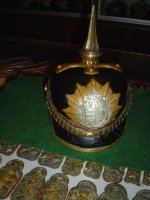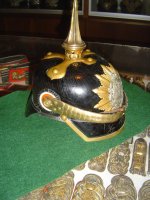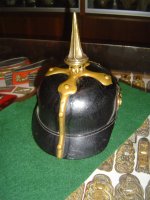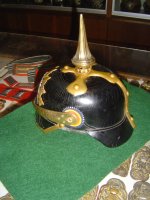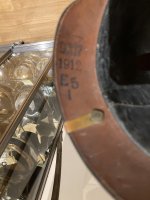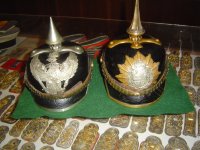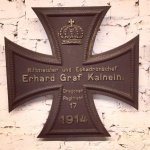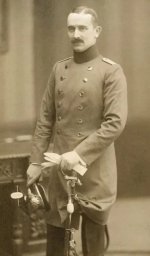You are using an out of date browser. It may not display this or other websites correctly.
You should upgrade or use an alternative browser.
You should upgrade or use an alternative browser.
Mecklenburg Dragoon Regt 17
- Thread starter KAGGR#1
- Start date
KAGGR#1
Well-known member
I think that it works both waysBravo !
you do find the best stuff Steve....or does it find you ?
Steve
2nd.Leibhusar
Well-known member
Excellent pieces as ever, Steve !! 


Khukri
Well-known member
-A great helmet. 1.Großherzoglich Mecklenburgisches Dragoner Regiment Nr.17. Ludwigslust. Been there!
-This Regiments Eskadrons charged at Halen.
From our book!
Second Charge -
1330 Hours. While 2nd Squadron impaled itself against the Zelk barricade position, 1st Squadron/Dr Nr 17 prepared to charge and destroy the Mettenberg artillery. At the small Halen railroad station, 1st Squadron stood at the wide loading wharf between the few houses that lined the Stationstraat. Their horses swayed their heads impatiently, as if already able to sniff death. Their riders could barely calm them. The cavalry troopers wore the black helmet with a sharp spike on top. The helmet sported a twelve-pointed star with the Mecklenburg-Schwerin coat of arms. From where they stood, they could see the outline of the Mettenberg Hill very clearly: small figures running around, moving bundles of straw. Jäger of Bn Nr 9, who sat smoking pipes, told them that the artillery firing on the village must be positioned there—not long before, they had seen black smoke rising from there. Squadron Commander Rittm. Erhard Graf von Kalnein had heard the incoming shells as he rode through the built-up area of Halen. Some shells had crashed nearby, but the only damages were some frightened horses. Kalnein had been unable to determine from where the shots had come.
In Kalnein's eyes, the terrain lay open before him—especially on the right. Flat country stretched out as far as the Mettenberg Hill. A few features rose up in front of him, but for approximately 200-300 meters he could see no obstacles with his binoculars. On his left seemed to be a few more trees and buildings, so he decided to shift to the north into the most open terrain. This would be his last decision—he died a few minutes later. His grave marker, shaped as an iron cross, marked his resting place for years at the IJzerwinning "Ehrenfriedhof Nr. 223" and is now kept in the Halen museum as a last reminder.
-the cover of our book shows a part of the painting of this charge. Rittmeister Graf von Kalnein leading.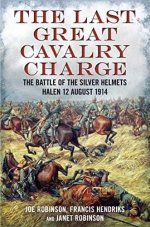
A picture of Rittmeister Erhard Graf von Kalnein when serving in a Garde Ulanen Regiment. And the grave marker. Now in the Battlefield Museum. Ehrenfriedhof Nr.223 was cleared in 1956. All the German fallen on smaller military cemeteries and on communal churchyards throughout Belgium were regrouped at larger cemeteries.
-This Regiments Eskadrons charged at Halen.
From our book!
Second Charge -
1330 Hours. While 2nd Squadron impaled itself against the Zelk barricade position, 1st Squadron/Dr Nr 17 prepared to charge and destroy the Mettenberg artillery. At the small Halen railroad station, 1st Squadron stood at the wide loading wharf between the few houses that lined the Stationstraat. Their horses swayed their heads impatiently, as if already able to sniff death. Their riders could barely calm them. The cavalry troopers wore the black helmet with a sharp spike on top. The helmet sported a twelve-pointed star with the Mecklenburg-Schwerin coat of arms. From where they stood, they could see the outline of the Mettenberg Hill very clearly: small figures running around, moving bundles of straw. Jäger of Bn Nr 9, who sat smoking pipes, told them that the artillery firing on the village must be positioned there—not long before, they had seen black smoke rising from there. Squadron Commander Rittm. Erhard Graf von Kalnein had heard the incoming shells as he rode through the built-up area of Halen. Some shells had crashed nearby, but the only damages were some frightened horses. Kalnein had been unable to determine from where the shots had come.
In Kalnein's eyes, the terrain lay open before him—especially on the right. Flat country stretched out as far as the Mettenberg Hill. A few features rose up in front of him, but for approximately 200-300 meters he could see no obstacles with his binoculars. On his left seemed to be a few more trees and buildings, so he decided to shift to the north into the most open terrain. This would be his last decision—he died a few minutes later. His grave marker, shaped as an iron cross, marked his resting place for years at the IJzerwinning "Ehrenfriedhof Nr. 223" and is now kept in the Halen museum as a last reminder.
-the cover of our book shows a part of the painting of this charge. Rittmeister Graf von Kalnein leading.

A picture of Rittmeister Erhard Graf von Kalnein when serving in a Garde Ulanen Regiment. And the grave marker. Now in the Battlefield Museum. Ehrenfriedhof Nr.223 was cleared in 1956. All the German fallen on smaller military cemeteries and on communal churchyards throughout Belgium were regrouped at larger cemeteries.
Attachments
Last edited:
Stosstrupp
Active member
Beautiful helmet great markings.

pickelhauben
Well-known member
What a find !
Zebedeus
Well-known member
Wonderful couple. The meck's one is a text-book stamp.Just in
This arrived yesterday
Mecklenburg D R 17
also I took a shot of D R 16 & D R 17 together
SteveView attachment 35250View attachment 35251View attachment 35252View attachment 35253View attachment 35254View attachment 35255
wonderful Helmet Steve, congrats!
James
James
KAGGR#1
Well-known member
Great post-A great helmet. 1.Großherzoglich Mecklenburgisches Dragoner Regiment Nr.17. Ludwigslust. Been there!
-This Regiments Eskadrons charged at Halen.
From our book!
Second Charge -
1330 Hours. While 2nd Squadron impaled itself against the Zelk barricade position, 1st Squadron/Dr Nr 17 prepared to charge and destroy the Mettenberg artillery. At the small Halen railroad station, 1st Squadron stood at the wide loading wharf between the few houses that lined the Stationstraat. Their horses swayed their heads impatiently, as if already able to sniff death. Their riders could barely calm them. The cavalry troopers wore the black helmet with a sharp spike on top. The helmet sported a twelve-pointed star with the Mecklenburg-Schwerin coat of arms. From where they stood, they could see the outline of the Mettenberg Hill very clearly: small figures running around, moving bundles of straw. Jäger of Bn Nr 9, who sat smoking pipes, told them that the artillery firing on the village must be positioned there—not long before, they had seen black smoke rising from there. Squadron Commander Rittm. Erhard Graf von Kalnein had heard the incoming shells as he rode through the built-up area of Halen. Some shells had crashed nearby, but the only damages were some frightened horses. Kalnein had been unable to determine from where the shots had come.
In Kalnein's eyes, the terrain lay open before him—especially on the right. Flat country stretched out as far as the Mettenberg Hill. A few features rose up in front of him, but for approximately 200-300 meters he could see no obstacles with his binoculars. On his left seemed to be a few more trees and buildings, so he decided to shift to the north into the most open terrain. This would be his last decision—he died a few minutes later. His grave marker, shaped as an iron cross, marked his resting place for years at the IJzerwinning "Ehrenfriedhof Nr. 223" and is now kept in the Halen museum as a last reminder.
-the cover of our book shows a part of the painting of this charge. Rittmeister Graf von Kalnein leading.View attachment 35257
A picture of Rittmeister Erhard Graf von Kalnein when serving in a Garde Ulanen Regiment. And the grave marker. Now in the Battlefield Museum. Ehrenfriedhof Nr.223 was cleared in 1956. All the German fallen on smaller military cemeteries and on communal churchyards throughout Belgium were regrouped at larger cemeteries.
Many thanks
IMO this adds a lot to the post
Steve

